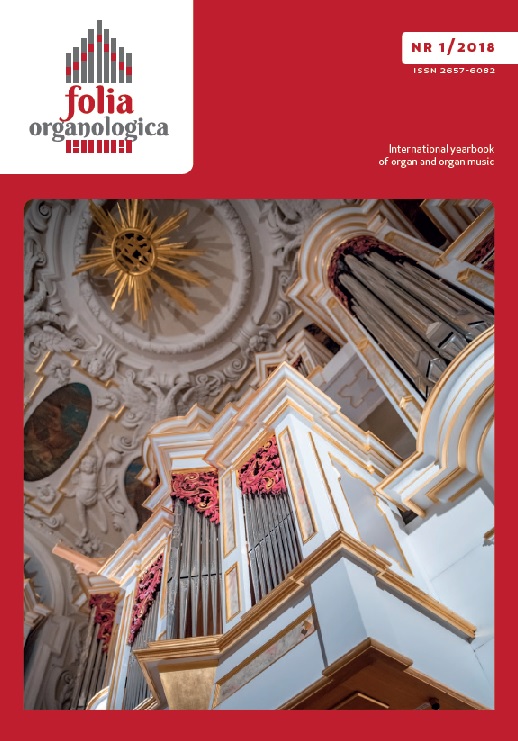Organy w kościele Świętego Krzyża w Bytomiu-Miechowicach. Historia i koncepcja rekonstrukcji
The Organ in the Church of the Holy Cross in Bytom-Miechowice. History and Concept of Reconstruction
Author(s): Franciszek KoenigSubject(s): Cultural history, Music
Published by: Uniwersytet Opolski
Keywords: organ;organ building;organ makers;Bytom-Miechowice;Schlag und Söhne;
Summary/Abstract: The article presents the history of the organ in the church dedicated to the Holy Cross in Bytom-Miechowice and the concept of recreating in the temple a historical instrument from 1905. History of the organ in the church of the Holy Cross in Miechowice dates back to at least a few centuries ago and concerns instruments found in the previous baroque church from the 17th century which was made famous by Fr. Norbert Bonczyk in the poem Old Church of Miechow from 1879. The earliest reports about the organ in Miechowice come from the visit protocols from the first half of the eighteenth century which mention the existence of 5-voice organ located on the music choir of the church. The studies on the church in Miechowice specify that the last organ in the so-called “old church of Miechow” was built in 1840 although no specific source is provided. Probably after the construction of the present church (the so-called new church) and its dedication in 1865, the organs were moved to the new temple. Archival research shows that at the end of the 19th century and at the beginning of the 20th century, the instrument was taken care of by, among others, T. Cieplik, once an organist of this church and later the founder of the musical conservatory in Bytom and a merchant, and E. Kurzer, an organ maker from Gliwice. The firm of Paul Berschdorf from Nysa also took part in renovating the organ in Miechowice. In the parish archives, bills have been kept which confirm the work of the mentioned people. Later, the organ was replaced with a new instrument. However, until 2014, it was not clear who its builder was and when it was built. The original documents were probably in the possession of the founders and they are not in the parish archives. It was only archival research abroad in Cologne and Leipzig in November and December 2014 (Universitats- und Stadtbibliothek Koln; Deutsche National Bibliothek Leipzig) which made it possible to establish that in 1905 the new 26-voice organ was built in the temple by Schlag und Sohne company from Świdnica. The instrument survived until the 1960s. Thanks to the research, its exact disposition is known and we have learnt that the company of Carl Berschdorf also worked on the instrument offering in 1939 its full extension to 42 voices. This project, however, was never realized due to the outbreak of World War II. In the 1960s, intensive work on removing the effects of mining damage was carried out in the church. Then, Schlag’s organ was dismantled and the case and the beautiful neo-gothic facade fitting the entire interior of the temple were destroyed. Fortunately, the only photograph of the Schlag organ prospectus has survived in the parish chronicle. In 1968, a temporary instrument was built on the basis of the former organ which remains in use today. Presently, further work is in progress being the next stage of saving the temple of the Holy Cross. First of all, the process of leveling the church must take place. A conception has therefore arisen that, in view of the need to completely renew the structure and interior of the temple, the historical 26-voice instrument from 1905 should be restored. An early project was prepared by Julian Gembalski from the Academy of Music in Katowice. Currently, work is underway to create technical and executive designs that are to be included in the overall cost estimate of the planned temple revitalization project. The matter seems more urgent since the cost estimates are to be approved in November 2019. The assumptions of the initial project by prof. J. Gembalski combine the desire to recreate the organ in its external form with a certain pragmatism in relation to the technical side of the instrument. In this case, it is not about making a faithful copy of Schlag’s organ, but rather a new instrument adapted to the place and time employing the latest achievements in the field of organ building. The project therefore includes the construction of the casing and having the architectural prospectus reconstructed in appropriate proportions based on the preserved photograph. The organ is to receive 26 voices divided into two manuals and pedal, but with a slightly widened range of keyboards which is to create better performance conditions for the music (up to “g3” in the manual and up to “f1” in the pedalboard). Although there were probably conical windchests in the historical instrument, it seems interesting to propose the use of electromagnetically operated slider and pallet windchests. What needs to be taken into account is not only the sound but also the durability of newer techniques and lower maintenance costs in the future. Still, when deciding to employ newer technical solutions, the quality of the sound cannot be overlooked. Therefore, there is a need to examine other Schlag und Sohne instruments from the same period in terms of parameters affecting the sound of the organ like mensuration, materials used, construction details of the pipes, and finally their intonation.
Journal: Folia Organologica. International yearbook of organ and organ music
- Issue Year: 2018
- Issue No: 1
- Page Range: 59-73
- Page Count: 15
- Language: English, Polish

